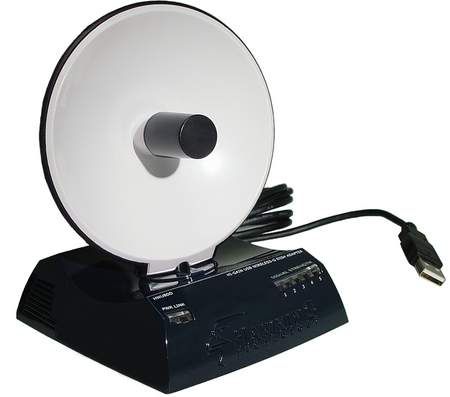Chances are you clicked the previous link because you were intrigued at what on earth a Hawking HWU8DD is.
But before you pause to wonder how on earth you would need a device that looks more comfortable in a fall out shelter than on the pages of Pocket-lint consider this: how boring is being disappointed by the fact that you aren't getting a good wireless signal strength around your house?
The shameful truth is that wireless networks, as wonderful as they are, rarely deliver on their promised connectivity rates throughout your entire property - unless you live in a shed.
One of the reasons for this is that the average wireless network card that ships with your PC is a cheap and nasty bit of kit, and one way they keep the cost down is by fitting a 2dBi antenna.
The bigger the dBi figure, the more powerful the signal it can receive. In the case of the High-Gain USB Wireless-G Dish Adapter, to give it it's suitably boring proper product name, this raises the dBi bar from 2 to 8, providing up to 22Mbps of throughput at 800 yards distance.
Lab coat off and comfy slippers on, out here in the real world this means that if you've got a computer in one part of the house that just can?t get a strong signal from your wireless access point, it can now.
The extra power of the antenna is aided by the satellite dish design which makes it highly directional, so you can simply point it in the direction of the access point and not worry about it being scattered all over the place.
The front mounted LEDs indicate signal strength, so you can fiddle around until they hopefully all light up and be sure you?ve hit Wi-Fi paydirt. In theory.
In practise we found it preferable to go with the standard software approach to ensuring the best signal strength as this produced more accurate results.
Much as we'd have liked to have been able to wall mount the device, the rotational range is rather restricted. Once you've got it sited properly and fine tuned, the jump in performance for anything but an already excellent signal is truly astounding.
Where no signal could penetrate before, we ended up with a "good" one, and where we were happy with "good" previously this became "excellent" instead.
In fact, wherever we tried it the signal improved, and our wireless networking experience became faster and more stable.
All of this without the need for an additional power supply as the Hawking is USB-host powered. What?s more, the value for money proposition is also a good one.
Take the "MIMO" alternative to boosting wireless availability around the house using a router with clever multi-antennae beaming the signal in all directions, and equally clever adapters that lock-on to the strongest ones available. These work well but you have to not only buy a new router but new adapters as well, for every PC you want connected using the system. If you?ve just got the one problem location it makes far more sense to invest ?50 in a single high-gain dish adapter for literally plug-and-play performance increases at a fraction of the cost of the MIMO upgrade.
Our quick take
It's not all perfect of course. For a start there's the bulk factor, at 90 x 116 x 75mm and thanks to the odd shape it's not exactly pocketable or portable enough for use on the go.
Nor is it the best looking of technology toys, unless you are into Star Wars retro in a big way.
And don't expect miracles: if one room gets absolutely no signal whatsoever an 8dBi antenna is unlikely to boost it into the excellent range, and depending upon the wall construction it may not make any difference at all.
In terms of bang for your buck we?ve not found a better solution for increasing wireless performance to a single poor reception node.

Hawking HWU8DD wireless adapter with built-in dish antenna - 4.0 / 5
| FOR | AGAINST |
|---|---|
|
|
To recap
Retro-style wireless tech that packs a powerful punch where reception is poor
